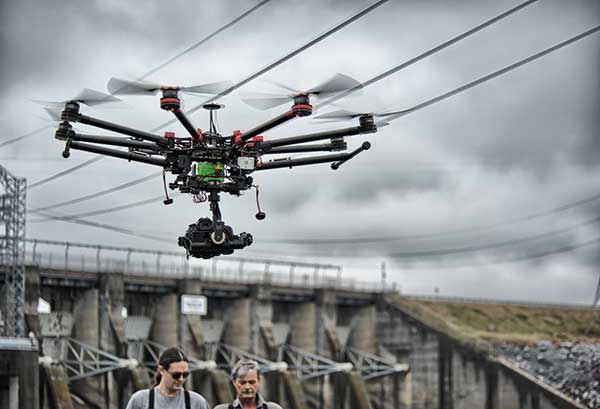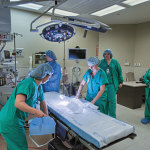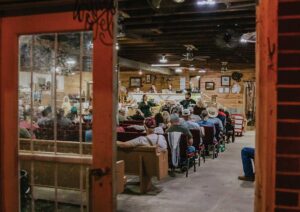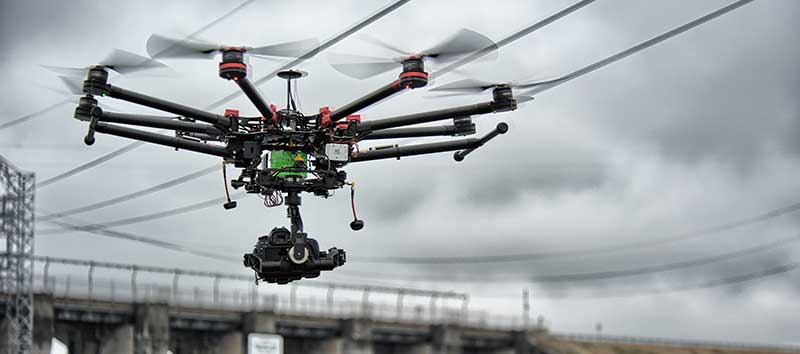
Capitalizing on the business of aerial drones
Story by Jim Smothers
Photos by Wallace Bromberg Jr.
You can thank General George S. Patton if you’ve seen a small UFO buzzing around Lake Logan Martin recently. Chances are good you were watching one of David Smith’s remote controlled copters. Smith and his son, Cameron, have three copters set up for taking videos and still photos, and they hope to get in on the ground floor of potential business opportunities using the small flying machines.
What does Patton have to do with it?
The colorful general put one of his ivory-handled pistols to the head of Smith’s father, Walter, during one of his infamous fits of anger during World War II. That evening, motorcycle courier Smith saw a sign in the mess hall asking for volunteers to sign up for the Army Air Corps, which seemed a much more attractive place to serve.
Smith flew 49 missions in B-17s, most of them in a bomber he named for his wife, the Birmingham Jewell. That plane flew 128 missions, a record at the time.
Smith returned to Alabama to operate an aviation business that inspired his sons to learn about flying, a family tradition now reaching down to his great grandson.
David Smith seemed destined to get involved with today’s generation of remotely controlled aircraft. His background includes remotely controlled aircraft, he’s been a licensed General Aviation pilot for 30 years, he worked as an electronics communication technician for a number of years, and more recently he has worked as a videographer for ESPN. If you’ve seen Chris Fowler and Desmond Howard on ESPN’s College Game Day, you’ve seen his work. He hasn’t missed a national championship game in 20 years.
Smith started flying string-controlled model airplanes when he was seven years old, and graduated to flying radio-controlled airplanes as a teenager. He and his brother, Walt, once mounted a small camera in the cockpit of one of their models and succeeded in taking photos during flight using old-school technology.
Call them what you will — drones, unmanned aerial vehicles, multirotor systems or remotely controlled airplanes and helicopters — they’ve gotten a lot of attention in the past few years. Military uses first caught the world’s attention, with pilots comfortably and safely operating surveillance and weapons systems from a safe distance, sometimes a half a world away.
Now there are remotely controlled copters so small and inexpensive they are being sold as toys and recommended for indoor use only.
Flightworthy units are also becoming more available and more affordable, opening the doors to new opportunities for recreation and service to more people.
Smith sees a number of ways to use the machines as flying camera platforms to provide valuable visual information in a number of ways. The regulatory environment is currently something of a gray area. The Federal Aviation Administration has been given until next year to propose rules and regulations for the small flying machines, and Smith wants to get in on the ground floor of providing low level aerial photography services.
He’s a member of the Association for Unmanned Vehicle Systems International (AUVSI), and he’s taking pains to be responsible with his flights.
“We don’t fly higher than 400 feet, we always keep a line of sight on them, and there’s always a spotter with me,” he said. “We also have $2 million of liability insurance.”
When taking a copter up, Smith is the pilot, and Cameron is the photographer. Cameron also makes sure his dad isn’t interrupted while flying.
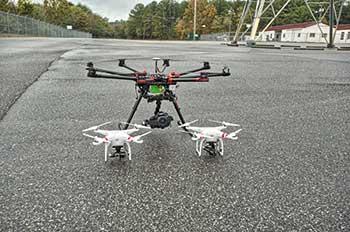 “If you’re out where other people are around, sometimes they’ll want to come up and talk while you’re flying,” he said. “Cameron talks to them until we get it back on the ground.”
“If you’re out where other people are around, sometimes they’ll want to come up and talk while you’re flying,” he said. “Cameron talks to them until we get it back on the ground.”
Smith said they’re careful not to fly over people, and to get permission before flying over other people’s property.
He and others interested in using the new technology are concerned that negative publicity could result in overregulation that would impair growth of a the new industry.
“The Association (AUVSI) estimates that by 2018 there could be 70,000 jobs created and $2 billion changing hands,” he said.
As for how they could be used, Smith said they could be helpful in many ways.
“Farmers could fly these over fields to survey crops and see if there are any problem areas, such as where water is needed. They could be used for inspections for cell phone and radio towers, solar panels and windmills without having to send a man up there,” he said.
They could also be used to assist in the inspections of bridges and steeples, reducing the danger and expense of putting a person at risk. Aerial photography can be used to monitor progress at construction sites, to survey tracts of property, and in providing detailed mapping. They could also be used in searches for missing persons and surveying damage after a storm or flood.
And of course, there are more traditional uses of the airborne cameras, providing new angle for photos and videos of landmarks, recreational activities, landscapes and more.
“There are thousands of ways these things can be used to make our lives better,” Smith said. “I see them all the time in movies and reality TV shows, too. You can tell. These can’t be flown higher than 400 feet, but airplanes and helicopters aren’t supposed to fly below 1,000 feet. There’s a much more detailed view at the lower level.”
But he has concerns about how negative publicity could result in unreasonable restrictions being placed on their use.
Even though they’re being used all over the country and around the world, most of the time news articles are written when there is a problem with them.
Smith mentioned a case in Serbia when someone flew a remote copter onto a soccer field carrying an Albanian flag during a match between the two countries.
“That just about caused a riot,” he said. “I don’t want to see idiots ruin it for the people that want to make a living doing this.”
He said reactions to the machines have been mixed. Most people seem to be interested and impressed by what they can do. Some see them as a threat to privacy.
“These things are as noisy as they can be,” Smith said. “I don’t see how you could use them to spy on anyone. But like anything else, it’s all in the hands of whoever is using it.”
Smith has used his copters to capture videos of windsurfers on the lake, unique views of Bald Rock at Mount Cheaha, of watching the floodgates open at Logan Martin Dam and many other scenes.
While there are toy remote copters available very cheaply, those capable of carrying higher quality cameras cost a bit more. The Smiths currently have three copters and accessories valued at about $30,000. Two of the units are DJI Phantom quadcopters equipped with GoPro cameras. The third is a more expensive and more powerful octocopter, which carries a Canon digital SLR. The camera mount for that copter — the gimbal — is equipped with servo motors to provide movement for different angles of view, and is so finely balanced it works only with one specific camera model and one specific lens. The gimbal alone was a $3,000 expense.
The octocopter with the camera mounted and batteries installed weighs in at 22 and a half pounds and provides about 15 minutes of flight time on a set of rechargeable batteries, which cost about $600.
The models he uses are equipped with GPS sensors that can detect their precise launching point. In the unlikely case that the remote control should fail, they are programmed to return to that spot on their own. They also sense their own battery levels, and are programmed to return to that spot before they lose power.
Smith said he typically spends about three hours on maintenance for every hour of flight time. He uses a torque tool to check every screw on every copter, and keeps logs on how many times each battery is used and charged. And like any good pilot, he uses checklists to make sure he’s not overlooking anything that could result in a failed flight.
Editor’s note: Smith expects his website to be up by the time this edition of Discover is published, where viewers can see some of his videos. Check it out at StarAerial.com











